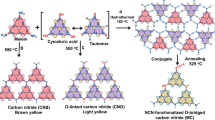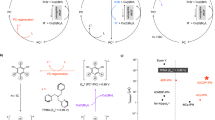Abstract
The photooxidative degradation and fragmentation behaviors of isotactic polypropylene (itPP) were simulated in laboratory after various postconditions, such as quenching, gradual cooling and drawing, using an artificial weathering machine and a blender. The crystallinity of the itPP films and orientation of the molecular chains play important roles in the photooxidation of the itPP films. Compared to quenched itPP films with the same ultraviolet (UV) exposure time, highly oriented itPP films and gradually cooled itPP films with higher crystallinity exhibited a lower rate of photooxidative degradation. To clarify the photooxidative degradation mechanism, the surface morphology, chemical structure, and microstructure of the UV-exposed itPP films were investigated using scanning electron microscopy, infrared spectroscopy, differential scanning calorimetry, and wide- and small-angle X-ray scattering. Photooxidative degradation was inhibited as the orientation degree of the itPP film increased. These results indicate that photooxidation likely occurs in the amorphous phase of itPP. Oriented molecular chains effectively slowed the photooxidative degradation of the itPP films. The artificial fragmentation test of UV-exposed itPP films showed that itPP films with lower crystallinity and orientation degrees were crushed into microplastics that were much smaller in size than those with higher crystallinity or orientation degrees.
This is a preview of subscription content, access via your institution
Access options
Subscribe to this journal
Receive 12 print issues and online access
$259.00 per year
only $21.58 per issue
Buy this article
- Purchase on SpringerLink
- Instant access to full article PDF
Prices may be subject to local taxes which are calculated during checkout








Similar content being viewed by others
References
Geyer R, Jambeck J, Law K. Production, use, and fate of all plastics ever made. Sci Adv. 2017;3:e1700782.
Geyer R Chapter 2 - Production, use, and fate of synthetic polymers. In: Letcher TM, editors. Plastic waste and recycling. Academic; 2020. p. 13–32.
Koelmans AA, Redondo-Hasselerharm PE, Nor NHM, de Ruijter VN, Mintenig SM, Kooi M. Risk assessment of microplastic particles. Nat Rev Mater. 2022;7:138–52.
Morales-Caselles C, Viejo J, Martí E, González-Fernández D, Pragnell-Raasch H, González-Gordillo JI, et al. An inshore–offshore sorting system revealed from global classification of ocean litter. Nat Sustain. 2021;4:484–93.
Jambeck J, Geyer R, Wilcox C, Siegler T, Perryman M, Andrady A, et al. Plastic waste inputs from land into the ocean. Science. 2015;347:768–71.
Meijer L, Emmerik T, Ent R, Schmidt C, Lebreton L. More than 1000 rivers account for 80% of global riverine plastic emissions into the ocean. Sci Adv. 2021;7:eaaz5803.
An Y, Kajiwara T, Padermshoke A, Nguyen T, Feng S, Mokudai H, et al. Environmental Degradation of nylon, poly(ethylene terephthalate) (PET), and poly(vinylidene fluoride) (PVDF) fishing line fibers. ACS Appl Polym Mater. 2023;5:4427–36.
Clark BL, Carneiro APB, Pearmain EJ, Rouyer MM, Clay TA, Cowger W, et al. Global assessment of marine plastic exposure risk for oceanic birds. Nat Commun. 2023;14:3665.
EFSA CONTAM Panel (EFSA Panel on Contaminants in the Food Chain). Statement on the presence of microplastics and nanoplastics in food, with particular focus on seafood. EFSA J. 2016;14:450.
Lim X. Microplastics are everywhere - but are they harmful? Nature. 2021;593:22–5.
Eriksen M, Lebreton LCM, Carson HS, Thiel M, Moore CJ, Borerro JC, et al. Plastic pollution in the world’s oceans: More than 5 trillion plastic pieces weighing over 250,000 tons afloat at sea. PLOS ONE. 2014;9:e111913.
Carpenter E, Smith K. Plastics on the Sargasso sea surface. Science. 1972;175:1240.
Eto R, Mokudai H, Masaki T, Matsuno H, Tanaka K. Hydrolysis properties of polyglycolide fiber mats mixed with a hyperbranched polymer as a degradation promoter. Polym J. 2024;56:55–60.
Science to enable sustainable plastics—A white paper from the 8th Chemical Sciences and Society Summit (CS3), 2020, rsc.li/sustainableplastics-report. https://www.rsc.org/globalassets/22-newperspectives/sustainability/progressive-plastics/c19_tl_sustainability_cs3_whitepaper_a4_web_final.pdf. Accessed 29 December, 2023.
Law K, Narayan R. Reducing environmental plastic pollution by designing polymer materials for managed end-of-life. Nat Rev Mater. 2022;7:104–16.
Lebreton L, Egger M, Slat B. A global mass budget for positively buoyant macroplastic debris in the ocean. Sci Rep. 2019;9:12922.
Padermshoke A, Kajiwara T, An Y, Takigawa M, Nguyen T, Masunaga H, et al. Characterization of photo-oxidative degradation process of polyolefins containing oxo-biodegradable additives. Polymer. 2022;262:125455.
Qin Y, Litvinov V, Chassé W, Sun J, Men Y. Environmental stress cracking of polyethylene pipe: Changes in physical structures leading to failure. Polymer. 2022;252:124938.
Nakatani H, Ohshima Y, Uchiyama T, Motokucho S. Degradation and fragmentation behavior of polypropylene and polystyrene in water. Sci Rep. 2022;12:18501.
Liu Q, Liu S, Xia L, Hu P, Lv Y, Liu J, et al. Effect of annealing-induced microstructure on the photo-oxidative degradation behavior of isotactic polypropylene. Polym Degrad Stab. 2019;162:180–95.
Wu H, Zhao Y, Su L, Wang K, Dong X, Wang D. Markedly improved photo-oxidation stability of α form isotactic polypropylene with nodular morphology. Polym Degrad Stab. 2021;189:109595.
Liu Q, Yang H, Zhao J, Liu S, Xia L, Hu P, et al. Acceleratory and inhibitory effects of uniaxial tensile stress on the photo-oxidation of polyethylene: Dependence of stress, time duration and temperature. Polymer. 2018;148:316–29.
Kajiwara T, An Y, Padermshoke A, Kumagai A, Marubayahi H, Ikemoto Y, et al. Characterization of microplastics by advanced analytical techniques. Bunseki Kagaku. 2022;71:541–47.
Takahara A, Kajiwara T, An Y. Analysis of formation process of polyolefin microplastics on the basis of polymer science. Bull Coast Oceanogr. 2023;61:89–93.
Lima MFS, Vasconcellos MAZ, Samios D. Crystallinity changes in plastically deformed isotactic polypropylene evaluated by X-ray diffraction and differential scanning calorimetry methods. J Polym Sci B: Polym Phys. 2002;40:896–903.
Krevelen DW, Nijenhuis K Chapter 5 - Calorimetric properties. In Properties of polymers (Fourth Edition). Elsevier, Amsterdam; 2009. p. 109–28.
Weidinger A, Hermans P. On the determination of the crystalline fraction of isotactic polypropylene from X-ray diffraction. Die Makromol Chem. 1961;50:98–115.
Yamaji K, Haisa M. Dynamic mechanical and X-ray studies of annealed isotactic polypropylene. Jpn J Appl Phys. 1976;15:225.
Alexander L X-ray diffraction methods in polymer science. John Wiley, New York, 1970.
Strobl GR, Schneider M. Direct evaluation of the electron density correlation function of partially crystalline polymers. J Polym Sci Polym Phys Ed. 1980;18:1343–59.
Tashiro K Crystal Structure analysis by wide-angle X-ray diffraction method. In: Tashiro K, editors. Structural science of crystalline polymers: Basic concepts and practices. Springer Nature Singapore; 2022. p. 1–285.
Dhingra VJ, Spruiell JE, Clark ES. The relationship between mechanical properties and structure in rolled polypropylene. Polym Eng Sci. 1981;21:1063–71.
Higashida Y, Watanabe K, Kikuma T. Mechanical properties of uniaxially and biaxially rolled polymer sheets. ISIJ Int. 1991;31:655–60.
Ballesteros O, Stefano F, Auriemma F, Girolamo R, Scoti M, Rosa C. Evidence of nodular morphology in syndiotactic polypropylene from the quenched state. Macromolecules. 2021;54:7540–51.
Lu Y, Wang Y, Chen R, Zhao J, Jiang Z, Men Y. Cavitation in isotactic polypropylene at large strains during tensile deformation at elevated temperatures. Macromolecules. 2015;48:5799–806.
White J, Shyichuk A. Macromolecular scission and crosslinking rate changes during polyolefin photo-oxidation. Polym Degrad Stab. 2007;92:1161–8.
Grause G, Chien M, Inoue C. Changes during the weathering of polyolefins. Polym Degrad Stab. 2020;181:109364.
Maiti P, Hikosaka M, Yamada K, Toda A, Gu F. Lamellar thickening in isotactic polypropylene with high tacticity crystallized at high temperature. Macromolecules. 2000;33:9069–75.
Isobe A, Uchiyama-Matsumoto K, Uchida K, Tokai T. Microplastics in the Southern Ocean. Mar Pollut Bull. 2017;114:623–6.
Acknowledgements
This work is based on results obtained from a project, PNP18016, commissioned by the New Energy and Industrial Technology Development Organization (NEDO). The authors also acknowledge the financial support of the JSPS Grant-in- for Scientific Research (Grant No. 26248053). WAXS and SAXS data were obtained at the BL38B1 beamline of the SPring-8 synchrotron facility in Japan with the approval of RIKEN.
Author information
Authors and Affiliations
Corresponding author
Ethics declarations
Conflict of interest
The authors declare no competing interests.
Additional information
Publisher’s note Springer Nature remains neutral with regard to jurisdictional claims in published maps and institutional affiliations.
Supplementary information
Rights and permissions
Springer Nature or its licensor (e.g. a society or other partner) holds exclusive rights to this article under a publishing agreement with the author(s) or other rightsholder(s); author self-archiving of the accepted manuscript version of this article is solely governed by the terms of such publishing agreement and applicable law.
About this article
Cite this article
An, Y., Kajiwara, T., Padermshoke, A. et al. Photooxidative degradation and fragmentation behaviors of oriented isotactic polypropylene. Polym J 56, 379–389 (2024). https://doi.org/10.1038/s41428-023-00876-4
Received:
Revised:
Accepted:
Published:
Issue date:
DOI: https://doi.org/10.1038/s41428-023-00876-4
This article is cited by
-
PJ ZEON Award for outstanding papers in Polymer Journal 2024
Polymer Journal (2025)
-
Enhancing anaerobic digestion of waste-activated sludge containing disposable face masks through hydrothermal pretreatment: improving methane production and reducing toxicity
Waste Disposal & Sustainable Energy (2025)
-
Changes in crystal morphology induced by lanthanide doping into diacetylene lamellar crystals
Polymer Journal (2024)



